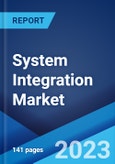The global system integration market size reached US$ 388.8 Billion in 2022. Looking forward, the publisher expects the market to reach US$ 627.3 Billion by 2028, exhibiting a growth rate (CAGR) of 8.3% during 2022-2028.
System integration refers to the process of connecting the physical and digital information technology (IT) infrastructure, including machine systems, inventory, databases, applications, protocols, formats, and data use patterns, into a centralized network.It assists in resolving the complexity associated with increased communication between systems and improving productivity and data consistency. At present, organizations from different end use industries rely on system integration solutions to minimize infrastructural investments and make faster decisions.
System integration refers to the process of connecting the physical and digital information technology (IT) infrastructure, including machine systems, inventory, databases, applications, protocols, formats, and data use patterns, into a centralized network.It assists in resolving the complexity associated with increased communication between systems and improving productivity and data consistency. At present, organizations from different end use industries rely on system integration solutions to minimize infrastructural investments and make faster decisions.
System integration Market Trends:
System integration is employed in the banking, financial services, and insurance (BFSI) industry to streamline and automate complex operations. This, coupled with the rising utilization of online banking services on account of the growing reliance on smartphones with high-speed internet, represents one of the key factors positively influencing the demand for system integration around the world. In addition, the escalatingdemand for cloud-based solutions in small and medium scale enterprises (SMEs) to maintain business data efficiently and effectively is contributing to the market growth. Apart from this, system integration is widely utilized to deliver comprehensive enterprise-class business solutions that help improve customer relations, enhance partner collaboration, and create efficiencies in supply chains and business operations. This, in turn, is creating lucrative business opportunities for key players operating in the industry. Besides this, the growing complexity and the rising scalability of business operations, along with the widespread adoption of advanced technologies, such as big data and software-as-a-service (SaaS), are increasing the need for distributed IT solutionsto streamline different systems. This is anticipated to create a positive influence on the demand for system integration in the upcoming years.Key Market Segmentation:
The publisher provides an analysis of the key trends in each sub-segment of the global system integration market report, along with forecasts at the global, regional and country level from 2023-2028. Our report has categorized the market based on service and end use industry.Breakup by Service:
- Infrastructure Integration
- Application Integration
- Consulting
Breakup by End Use Industry:
- BFSI
- Government
- Manufacturing
- Telecommunications
- Retail
- Oil and Gas
- Healthcare
- Others
Breakup by Region:
- North America
- United States
- Canada
- Asia Pacific
- China
- Japan
- India
- South Korea
- Australia
- Indonesia
- Others
- Europe
- Germany
- France
- United Kingdom
- Italy
- Spain
- Russia
- Others
- Latin America
- Brazil
- Mexico
- Others
- Middle East and Africa
Competitive Landscape:
The competitive landscape of the market has been analyzed in the report, along with the detailed profiles of the major players operating in the industry. Some of these players are Accenture Plc, BAE Systems plc, Capgemini Services SAS, CISCO SYSTEMS INC., Dell Technologies, Inc., Fujitsu Limited, HCL Technologies Ltd., Hewlett Packard Enterprise Company (HPE), IBM Corporation, Infosys Limited, Oracle Corporation, Tata Consultancy Services Limited (TCS), and Wipro Limited.Key Questions Answered in This Report:
- How has the global system integration market performed so far and how will it perform in the coming years?
- What has been the impact of COVID-19 on the global system integration market?
- What are the key regional markets?
- What is the breakup of the market based on the service?
- What is the breakup of the market based on the end use industry?
- What are the various stages in the value chain of the industry?
- What are the key driving factors and challenges in the industry?
- What is the structure of the global system integration market and who are the key players?
- What is the degree of competition in the industry?
Table of Contents
1 Preface3 Executive Summary10 Value Chain Analysis12 Price Analysis
2 Scope and Methodology
4 Introduction
5 Global System Integration Market
6 Market Breakup by Service
7 Market Breakup by End Use Industry
8 Market Breakup by Region
9 SWOT Analysis
11 Porters Five Forces Analysis
13 Competitive Landscape
List of Figures
List of Tables
Companies Mentioned
- Accenture Plc.
- BAE Systems Plc.
- Capgemini SA.
- Cisco Systems Inc.
- Dell Inc.
- Fujitsu Limited (Furukawa Group)
- HCL Technologies Limited
- Hewlett Packard Enterprise Company
- IBM Corporation
- Infosys Limited
- Oracle Corporation
- Tata Consultancy Service Limited and Wipro Limited
Methodology

LOADING...
Table Information
| Report Attribute | Details |
|---|---|
| No. of Pages | 141 |
| Published | November 2023 |
| Forecast Period | 2022 - 2028 |
| Estimated Market Value ( USD | $ 388.8 Billion |
| Forecasted Market Value ( USD | $ 627.3 Billion |
| Compound Annual Growth Rate | 8.3% |
| Regions Covered | Global |
| No. of Companies Mentioned | 12 |









